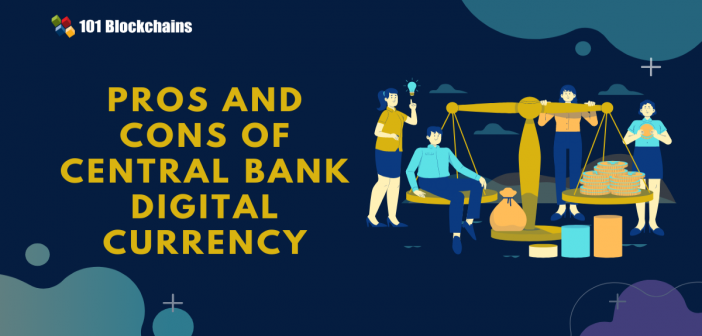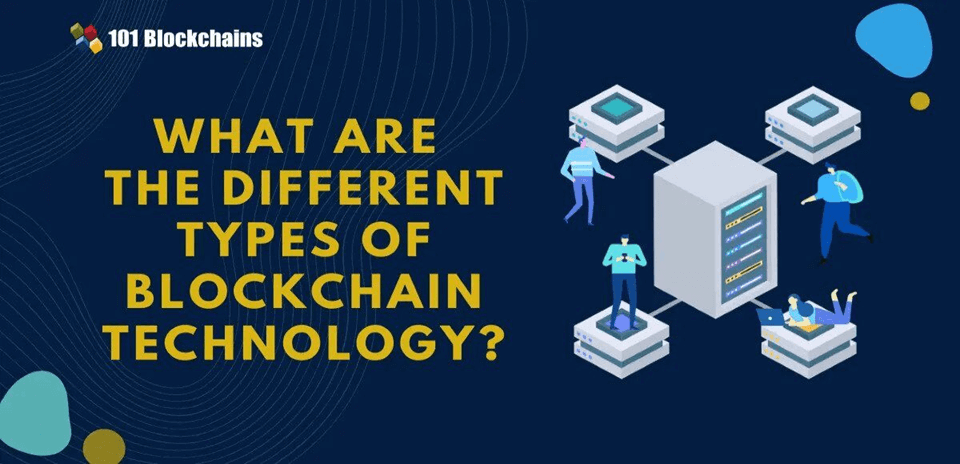Learn how blockchain truly works, master key definitions, and uncover what makes smart contracts so "smart." Dive into the fundamentals, gain valuable insights, and start your blockchain journey today!

- Reviews
Diego Geroni
- on February 20, 2021
Pros and Cons of Central Bank Digital Currency
The following discussion outlines an overview of the different existing CBDC initiatives that could provide a strong foundation for understanding central bank digital currency pros and cons.
Technological advancements and the reducing use of cash have prompted various central banks to investigate the possibilities of introducing digital alternatives to cash. Digitalization is continuously transforming economic activity while bringing in many disruptions for society, alongside revolutionizing many aspects of the daily life of an individual. As a result, it invites many concerns for revising conventional approaches. So, with the reduced use of cash and increasing preferences of customers for digital payment systems, central banks are doubtful about introducing CBDCs.
Therefore, it is important to have a clear impression of the central bank digital currency pros and cons for arriving at a reasonable conclusion. Many central banks have actively invested efforts in researching the outcomes of adopting CBDC. However, many of the central banks are hesitating to implement CBDC concept papers in practice.
As a digital alternative to physical central bank money, CBDC can offer many advantages. However, the central bank digital currency cons present implications for instability in monetary policy and the financial services industry in general. The following discussion outlines the background of CBDCs and the essential assumptions before diving into their advantages and setbacks.
Want to develop expertise in the CBDC Space? Enroll Now: Central Bank Digital Currency Masterclass
Introduction and Background of CBDC
The influence of technology has birthed ideas for new approaches to payment systems, thereby resulting in prospects for CBDC. The arrival of CBDCs has pointed out the possibilities of technological modifications working both ways in the monetary policy. Companies using blockchain technology have been able to develop new payment systems that can bypass the role of central banks in a settlement. At the same time, central banks are considering the possibilities for offering new forms of retail payment channels, capable of bypassing the role of intermediaries.
What is CBDC?
Before moving ahead with the outline of central bank digital currency pros and cons, it is important to understand the difference of central bank digital currency from traditional reserves. You can differentiate CBDC from traditional reserves by reflecting on its definition. Although there is no clear definition of CBDC, you can consider it as an electronic form of central bank money. However, CBDC features certain traits that establish its uniqueness.
First of all, it offers better and broader access functionalities in comparison to reserves. CBDC also present better exceptionally better functionality in the case of retail transactions when compared to cash. CBDC also includes a distinct operational structure when compared to other variants of central bank money, thereby allowing the CBDC for addressing a distinct core purpose.
Most important of all, a CBDC should have the capability for bearing interest, only with realistic assumptions for paying interest rates, different from the rate on reserves. Central bank digital currency is also considered as central bank e-money as well as an electronic liability for the central bank. As a liability of the central bank, it can be in the form of a token or stored in an account for executing transactions as well as maintaining value. The diverse aspects related to CBDC completely put down the possibilities of central bank digital currency cons. However, there is no reason to negate them completely.
Other digital currencies are threatening the very existence of CBDC. For example, Facebook is already working on a digital currency called Libra. Novi wallet is the primary blockchain wallet compatible with it as of now. However, it’s a massive concern for Central banks because this currency can pose a threat to the monetary system and fiat currencies.
Build your identity as a certified blockchain expert with 101 Blockchains’ Blockchain Certifications designed to provide enhanced career prospects.
Different Forms of CBDC
The new taxonomy of money also points out possibilities for drawing differences between two potential forms of CBDCs. The most significant traits of money, according to the new definitions, focus on the issuer, form, accessibility, and transfer mechanism. The issuer might be a central bank or any other entity.
The form in the definition of money refers to electronic and physical money. In terms of accessibility, money could take on two options, such as limited or universal access. The transfer mechanism of money could be centralized or decentralized (peer-to-peer) in nature.
As a result, the new aspects included in the definition of money provide the reliable foundation for differentiating the two forms of electronic CBDC, such as central-bank issued and peer-to-peer variants. The retail CBDC is available for the general public, and the wholesale CBDC variant is available only for financial institutions. Now, it is important to establish the specific assumptions about CBDC for reflecting on the central bank digital currency pros and cons.
General Assumptions about CBDCs
The first assumption about CBDC is that they are not crypto-assets like Bitcoin. CBDCs can choose to adopt DLT that can serve as a similar link between CBDC and cryptocurrencies. However, CBDCs are considerably different from cryptocurrencies as they would serve as liability of the central bank, at par with banknotes.
Basically, one of the prominent central bank digital currency pros i.e. trust, separates CBDCs from cryptocurrencies or stablecoins. The second factor points out to the conventional approach of central banks issuing digital money in reserves. On the contrary, the CBDC designs considered in many central bank proposals imply the need for token-based CBDCs. As a result, CBDC is different from balances in reserve accounts and common variants of commercial bank money are in the account-based format.
It is also important to notice that the popularity of CBDC does not depend only on the new technological improvements. As discussed earlier, card usage has been declining constantly alongside drastic reduction in the use of cash.
Want to know more about cryptocurrency? Enroll Now in Cryptocurrency Fundamentals Course
A Better Alternative
Central banks want to create an alternative method of payment and storing value rather than abolishing cash completely with CBDCs. Central banks want to prepare for a potential future where physical cash could no longer qualify as legal tender.
There are many blockchain solutions for central bank digital currency. So, the introduction of CBDCs could help in offering a trustworthy and flexible payment method for consumers in alignment with the trend of digitalization. On the other hand, the reducing use of cash is creating notable concerns regarding financial system stability and stability of the economy as a whole.
All these assumptions clearly show that central bank digital currency cons are evident in technological, system, legal and economic aspects. In addition, the ethical concerns gain attention with focus on traceability in the design of CBDC or guarantee of anonymity.
However, users could most likely prefer CBDC on the grounds of payment, associated functionality and total costs for the users. It is also important to consider the importance of technological expertise, courage and a vision for CBDC implementation. Central bank digital currency pros become appealing instruments for drawing the attention of central banks towards CBDCs especially with the restrictions in current payment infrastructure in terms of technological supplements and add-ons. As a result, the demand for new payment models is increasing considerably in recent times.
Excited to know the difference between Cryptocurrency and CBDC, Checkout detailed guide on Crypto vs CBDC.
Current CBDC Initiatives
With the assumptions regarding CBDCs becoming clear, it is important to reflect on the existing CBDC initiatives. An overview of the existing CBDC initiatives can provide a critical perspective on central bank digital currency cons and advantages. Let us find out more about existing CBDC initiatives for driving clarity on the comparison between central bank digital currency pros and cons.
Central banks employ different design approaches, methods, technologies and stakeholder participation for current CBDC research projects. A study by the Bank of International Settlement (BIS) established that around 70% of the central banks in the study affirmed their engagement with specific form of CBDC work.
For example, U.S. is currently developing a new type of digital asset called digital dollar. This initiative will definitely affect the global economy and initiate a drastic change. At present they are planning to work on a digital dollar wallet for storing all of the digital currencies. Even though it’s a digital currency federal banks will be responsible for regulating and maintaining the value.
All the central banks involved in the study showed that they had started theoretical and conceptual research pertaining to CBDC. Interestingly, almost half of the central banks surveyed in the study stated that they had already moved to the proof-of-concept and functionality-oriented phases. Presently, many central banks are working on pilot e-coin projects.
Design Factors of CBDC
The design features of CBDC such as scalability, security, interoperability, flexibility and accessibility are critical components associated with the design in the proposed CBDC designs.
One of the prominent mentions among real implementations of CBDC refers to E-krona initiative in Sweden. The radical decline in use of cash alongside technological affinity of people in Sweden has been critical in issuing the central bank-issued cryptocurrency.
Therefore, one could directly find out one of the notable central bank digital currency pros in this real-life example. However, the Swedish Central Bank is not considering distributed ledger technology as the basis for the E-krona solution.
The Swedish Central Bank aims to ensure broader availability of E-krona to the general public at any time, 24/7. On the other hand, one of the central bank digital currency cons noted in this case refers to the fact that it would not bear interest in the initial days. Furthermore, there is no agreement over placing E-krona in an account with Riksbank or storing them as value-based units in an app or locally on a card.
Other Initiatives
The Monetary Authority of Singapore or MAS and the Bank of Canada have also flagged off projects for deriving insights regarding the use of digital currencies. Presently, the Bank of Canada is working on the ‘Project Jasper’ initiative, bringing the public and private sectors in collaboration for understanding the ways in which distributed ledger technology could transform the complete payments system.
The ‘Project Ubin’ initiative in Singapore also focuses on the utilization of DLT for clearing and settlement for securities and payments. The project showcases central bank digital currency pros as it can support MAS and the industry in understanding the potential of CBDCs. In addition to these notable mentions, many other CBDC projects are currently under progress across various regions. For example, the Bank of Thailand has launched the Project Inthanon and the Bank of Japan and the European Central Bank have collaborated for Project Stella initiative.
China is launching a CBDC project called DCEP project. This is surely going to be one of the groundbreaking changes in our global economic history. However, it’s backed up by the government and they are responsible for regulating it.
Start learning Blockchain with World’s first Blockchain Skill Paths with quality resources tailored by industry experts Now!
Pros and Cons with Central Bank Digital Currencies
After an overview of the fundamentals of CBDC and the basic assumptions about them alongside the current CBDC implementations, let us proceed towards the central bank digital currency cons and pros. Central banks face issues in considering CBDC adoption due to the vague nature of evaluating possibilities for digital fiat currency.
Furthermore, central banks should also notice positive and negative implications of digital fiat currency for financial stability and monetary policy. Therefore, the assessment of central bank digital currency pros and cons assume that they are associated with central bank functions. Now, let us take a look at the positives and negatives associated with central bank digital currency in detail.
Central Bank Digital Currency Pros
Central bank digital currency or CBDC has emerged as a promising choice for central banks to compete with digital money. The recently launched initiatives in the crypto asset sector by tech giants such as Facebook paint CBDCs as favorable options. However, it is important to look at the central bank digital currency pros to find out the value they offer. Here is a look at some of the notable advantages with central bank digital currencies that you should consider.
- The foremost positive aspect in central bank digital currency refers to the lower transaction costs. CBDCs can provide the support for faster institutional and retail payments with reduced transaction costs.
- Central bank digital currency pros also focus particularly on fostering economic growth alongside digital innovation. CBDCs could offer a trustworthy digital currency jurisdiction alongside creating a very appealing crypto ecosystem. As a result, they can lead to improved economic activity alongside encouraging the spill-over effects in other technology sectors.
- CBDCs can provide a considerably cost-efficient alternative to cash for value storage. The cost factor is lower in CBDCs as it doesn’t impose burden on costs for production, storage, transportation, and disposal. At the same time, CBDCs also present safe alternatives for distribution and reduction of concerns regarding fraud in the payment ecosystem.
- Organizations could gain the reputation of a trailblazer by capitalizing on the opportunities with CBDC in the nascent stages. By expressing an active interest in CBDC in the early stages, a company can pioneer definitions of monetary policy regarding CBDCs. Subsequently, companies working on CBDC could also play a crucial role in defining the various applicable standards with CBDC.
- Liquidity is a prominent factor among central bank digital currency pros by helping central banks offer short-term liquidity support. Interestingly, users can avail the liquidity benefits with CBDC on bank holidays too. Therefore, CBDCs can be helpful for effective reduction in risks of individual institutions being involved in systemically triggering chain reactions.
- Financial inclusion comes immediately to the mind when you think of CBDCs. Central bank digital currencies could help in improving the access to digital payments for a majority of unbanked households. CBDCs can help users in accessing current digital payment tools at considerably lower or zero costs, without a bank account.
- The introduction of CBDCs could also increase competition in the payment systems landscape. Additionally, they can also foster motivation among private players for innovation. Furthermore, central bank digital currency pros can also increase competition among banks. Banks would compete for attracting bank deposits related to assets that could possibly migrate to CBDC.
- The most important benefit that you can find with CBDCs refers to the lack of involvement of intermediaries. As a result, CBDCs could play a crucial role in increasing the speed of settlement alongside support for real-time payments. As you can see there are a lot of similarities to the features of blockchain technology.
- Finally, CBDCs could also act as a direct monetary policy tool with the condition that it bears interest. Therefore, it can support improved direct control over the money supply.
- Central bank digital currency pros also point out towards better privacy levels. They can provide the assurance of better anonymity in comparison to the current commercial bank card payments.
Central Bank Digital Currency Cons
After reflecting on the pros of central bank digital currency, let us reflect on the central bank digital currency cons. They can offer a better impression of the potential of CBDC. Here are the notable setbacks you can find with CBDCs.
- CBDCs have prominent geographic restrictions as they are accepted only in the country that issues them.
- Central banks could turn into direct competitors of payment service providers, thereby forcing banks to lose income. Furthermore, new investment opportunities with CBDC could reduce the consumer deposit demand. Subsequently, CBDCs can lower bank lending to the general economy and the economic growth.
- Crypto-based CBDCs do not have any links to conventional currency and could showcase higher price volatility.
- Central bank digital currency cons also point out the increased competition for commercial banks. The nature of CBDCs as a substitute for bank deposits can motivate banks to increase their deposit rates. Then, it can result in a transition to wholesale funding from deposit funding.
- Central bank digital currencies can also increase the risks of system-wide bank runs. Such types of bank runs could increase faster in times of financial crisis without any dependence on time and proximity.
Start learning Blockchain with World’s first Blockchain Career Paths with quality resources tailored by industry experts Now!
Conclusion
As you can notice clearly, central bank digital currencies present different propositions for early adopters. While central bank digital currency pros present clear invitations to issue CBDCs immediately, the cons paint a completely contrasting image. However, the central bank digital currency cons provide the ideal insights for prohibited practices in CBDC implementation.
If you want to learn more about central bank digital currencies, then you need to choose 101 Blockchains. We have introduced a CBDC Masterclass recently on our platform for all aspiring learners. You can access the support of industry experts in learning about CBDCs with our masterclass. Register now and dive into the world of central bank digital currencies!
*Disclaimer: The article should not be taken as, and is not intended to provide any investment advice. Claims made in this article do not constitute investment advice and should not be taken as such. 101 Blockchains shall not be responsible for any loss sustained by any person who relies on this article. Do your own research!





